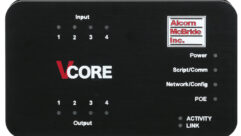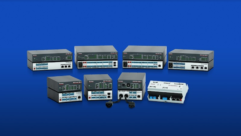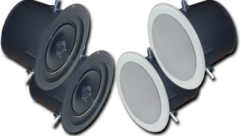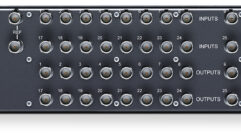A primary challenge in AV control system design is balancing system flexibility with user-friendliness and in recent years great strides have been made in this respect. By automating, sequencing and synchronizing commands, control systems can be custom tailored for users and their specific environment. While the use of IP-based systems has grown, there is still a wide market of control devices that also employ serial, IR, and relay triggered activation. The systems shown here demonstrate the rich variety of AV control systems and methods currently available.
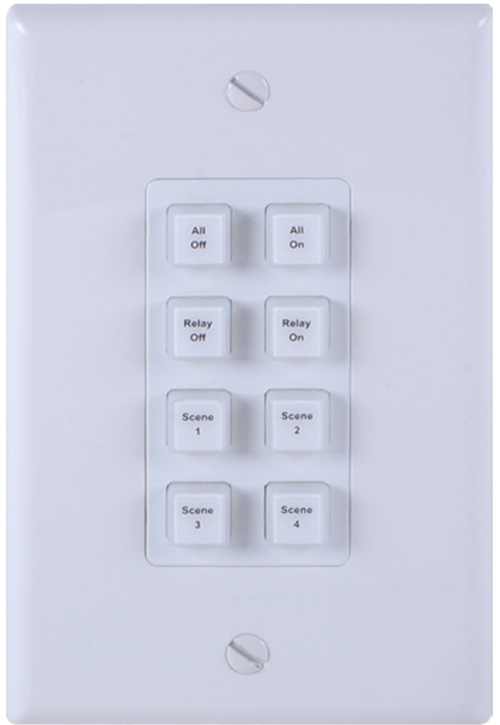 Showcasing versatility in a very compact format, A-Neuvideo’s ANI-8WP wallplate control system installs in a standard one-gang light switch box and features eight programmable direct macro buttons on the front along with an Ethernet port on the back. An additional eight macros can be set up through the WebGUI. Up to 16 commands can be sent from each button. The unit also has a rear mounted relay port for more device control, and events can be arranged to automatically activate through time and date settings. The power can be provided through an external supply or via PoE. Included are 56 button labels, 28 of which are pre-printed and 28 are blank.
Showcasing versatility in a very compact format, A-Neuvideo’s ANI-8WP wallplate control system installs in a standard one-gang light switch box and features eight programmable direct macro buttons on the front along with an Ethernet port on the back. An additional eight macros can be set up through the WebGUI. Up to 16 commands can be sent from each button. The unit also has a rear mounted relay port for more device control, and events can be arranged to automatically activate through time and date settings. The power can be provided through an external supply or via PoE. Included are 56 button labels, 28 of which are pre-printed and 28 are blank.
 The Alcorn-McBride V16X show controller can accomplish heavy duty control tasks through a very easy scripted setup and programming routine. The device has four Ethernet ports, 16 serial ports, DMX, SMPTE timecode, digital IO, GPS, and a builtin LCD display. It is possible to run SMPTE timecode sequenced control of devices, audio, video, lighting and special effects. Events may also be triggered by simple contact closures assigned to doors, windows, pressure pads, and other components. Accessories include I/O expansion units and ShowTouch touch screen interfaces of various sizes. The primary market for the V16X includes but is not limited to theme parks, museums, and specialty exhibits.
The Alcorn-McBride V16X show controller can accomplish heavy duty control tasks through a very easy scripted setup and programming routine. The device has four Ethernet ports, 16 serial ports, DMX, SMPTE timecode, digital IO, GPS, and a builtin LCD display. It is possible to run SMPTE timecode sequenced control of devices, audio, video, lighting and special effects. Events may also be triggered by simple contact closures assigned to doors, windows, pressure pads, and other components. Accessories include I/O expansion units and ShowTouch touch screen interfaces of various sizes. The primary market for the V16X includes but is not limited to theme parks, museums, and specialty exhibits.
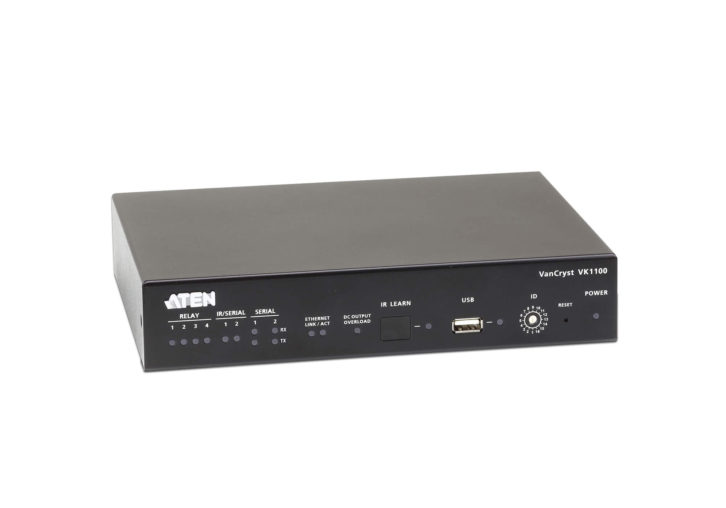 The ATEN VK1100 control box from ATEN works at the center of the Ethernet-based ATEN control system. It’s operated from iOS, Android, or Windows mobile devices via the ATEN control system app after configuration through the VK6000 Configurator software. The free standing or rack mounted unit connects to A/V equipment, lighting, conference systems, air conditioning, motion sensors, and power switches in the room on bidirectional and single direction RS232 ports, IR terminals, and relays. Viewer profiles may be imported and updated using a point-and-tap user interface.
The ATEN VK1100 control box from ATEN works at the center of the Ethernet-based ATEN control system. It’s operated from iOS, Android, or Windows mobile devices via the ATEN control system app after configuration through the VK6000 Configurator software. The free standing or rack mounted unit connects to A/V equipment, lighting, conference systems, air conditioning, motion sensors, and power switches in the room on bidirectional and single direction RS232 ports, IR terminals, and relays. Viewer profiles may be imported and updated using a point-and-tap user interface.
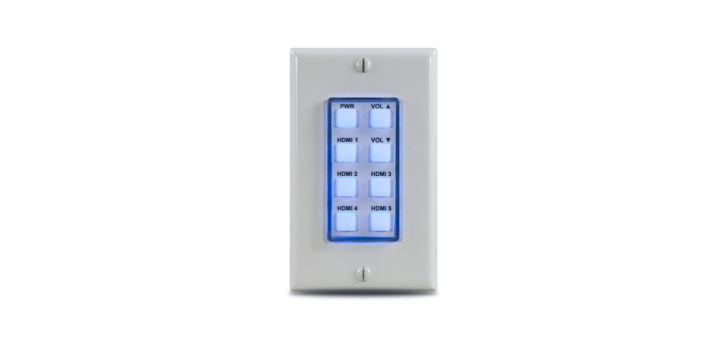 The Atlona AT-ANC-108D eight button network control panel is a remote control panel for Atlona IP-based products. Connected by a single CAT cable, the box installs into a single gang light switch enclosure. The eight soft-touch, backlit buttons are identified with customizable, pre-cut labels and the panel is powered through PoE to greatly simplify installation. Configured with the free Atlona Management System (AMS) software or the embedded web server, the panel sends commands to an Atlona switcher such as the AT-UHD-CLSO-612ED and the switcher relays those commands to AV devices via RS-232 signals.
The Atlona AT-ANC-108D eight button network control panel is a remote control panel for Atlona IP-based products. Connected by a single CAT cable, the box installs into a single gang light switch enclosure. The eight soft-touch, backlit buttons are identified with customizable, pre-cut labels and the panel is powered through PoE to greatly simplify installation. Configured with the free Atlona Management System (AMS) software or the embedded web server, the panel sends commands to an Atlona switcher such as the AT-UHD-CLSO-612ED and the switcher relays those commands to AV devices via RS-232 signals.
 The Aurora RXC-4 is a Quad Core IP Control System, pitched for conference rooms, educational facilities, digital signage, and more. With full web server capabilities, the RXC-4 can serve up web control pages to any iPad/Android/Microsoft tablet or web browsing device. The RXC-4 has a variety of on-board ports to control equipment such as but not limited to serial ports for devices like projectors, IR Ports for BluRay players, relays for screen or shade control, and I/O Ports for door and motion sensor devices. The dual-port 1Gbps LAN is accessible for TCP/ IP, HTTP Post, UDP, and Telnet Control of virtually unlimited amount of Ethernet based AV devices.
The Aurora RXC-4 is a Quad Core IP Control System, pitched for conference rooms, educational facilities, digital signage, and more. With full web server capabilities, the RXC-4 can serve up web control pages to any iPad/Android/Microsoft tablet or web browsing device. The RXC-4 has a variety of on-board ports to control equipment such as but not limited to serial ports for devices like projectors, IR Ports for BluRay players, relays for screen or shade control, and I/O Ports for door and motion sensor devices. The dual-port 1Gbps LAN is accessible for TCP/ IP, HTTP Post, UDP, and Telnet Control of virtually unlimited amount of Ethernet based AV devices.
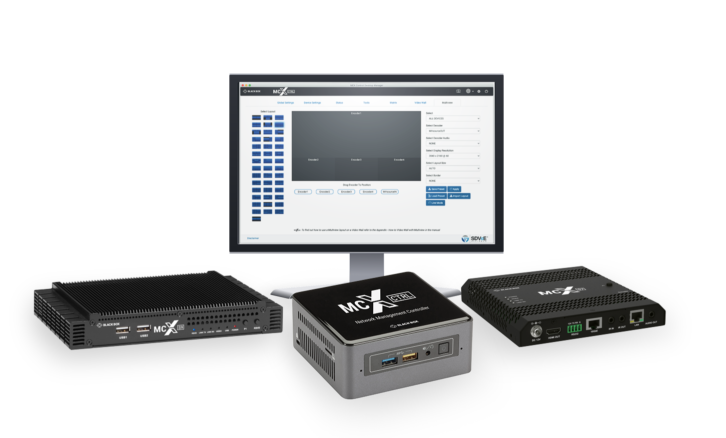 In February the Black Box MCX Gen 2 Controller debuted. It’s an SDVoE all-inone network controller and manager for the Black Box MCX AV-over-IP (AVoIP) multimedia distribution and management system. Enabling complete control over the MCX system, the new controller simplifies setup and management of MCX AVoIP systems, facilitates full asset tracking of devices with real-time status monitoring, and offers strong security to ensure continual protection of data and content. The new MCX Gen 2 Controller streamlines setup by accepting CSV imports and allowing users to assign icons to source and display endpoints for easy identification. Users can create browser-based interfaces to control essential functions for the control matrix, video wall, and multiview functions, as well as external devices including displays and media players. The controller also has flexible EDID handling with full reporting of monitor information. A PIN-coded QR system supports creation of no-touch UIs, making setup of touch panels and control boards both simple and cost-free. An array of testing, automation, and security features round out the controller.
In February the Black Box MCX Gen 2 Controller debuted. It’s an SDVoE all-inone network controller and manager for the Black Box MCX AV-over-IP (AVoIP) multimedia distribution and management system. Enabling complete control over the MCX system, the new controller simplifies setup and management of MCX AVoIP systems, facilitates full asset tracking of devices with real-time status monitoring, and offers strong security to ensure continual protection of data and content. The new MCX Gen 2 Controller streamlines setup by accepting CSV imports and allowing users to assign icons to source and display endpoints for easy identification. Users can create browser-based interfaces to control essential functions for the control matrix, video wall, and multiview functions, as well as external devices including displays and media players. The controller also has flexible EDID handling with full reporting of monitor information. A PIN-coded QR system supports creation of no-touch UIs, making setup of touch panels and control boards both simple and cost-free. An array of testing, automation, and security features round out the controller.
 The Crestron CP4N 4-Series control system is a single rack space unit with an upgraded multicore CPU. Add-on control capability includes touch screens, wireless remotes, and mobile device apps as well as Crestron Fusion software and the Crestron XiO Cloud service. Capable of running ten programs simultaneously, the CP4N can have one program changed without affecting the others. Crestron lighting dimmers, motorized shades, sensors, thermostats, and keypads can be linked on the CrestNet network while third party AV devices can connect on RS-232, IR/serial, relay, and Versiport I/O control ports.
The Crestron CP4N 4-Series control system is a single rack space unit with an upgraded multicore CPU. Add-on control capability includes touch screens, wireless remotes, and mobile device apps as well as Crestron Fusion software and the Crestron XiO Cloud service. Capable of running ten programs simultaneously, the CP4N can have one program changed without affecting the others. Crestron lighting dimmers, motorized shades, sensors, thermostats, and keypads can be linked on the CrestNet network while third party AV devices can connect on RS-232, IR/serial, relay, and Versiport I/O control ports.
 The Contemporary Research IP-DXL Display Control Center supports display control over Ethernet, sending control commands as UDP broadcast data packets to all QIP-D and QIP-DVX IPTV Decoder/Controllers on the network. Its flexibility allows it to communicate with individual displays, groups, zones, or all displays using any one of three software options: the onboard DX Lite web page, Display Express Software from Contemporary Research, or third-party control systems. The IP-DXL Display Control Center can send commands for channel, volume and power; custom programming is not required for display control.
The Contemporary Research IP-DXL Display Control Center supports display control over Ethernet, sending control commands as UDP broadcast data packets to all QIP-D and QIP-DVX IPTV Decoder/Controllers on the network. Its flexibility allows it to communicate with individual displays, groups, zones, or all displays using any one of three software options: the onboard DX Lite web page, Display Express Software from Contemporary Research, or third-party control systems. The IP-DXL Display Control Center can send commands for channel, volume and power; custom programming is not required for display control.
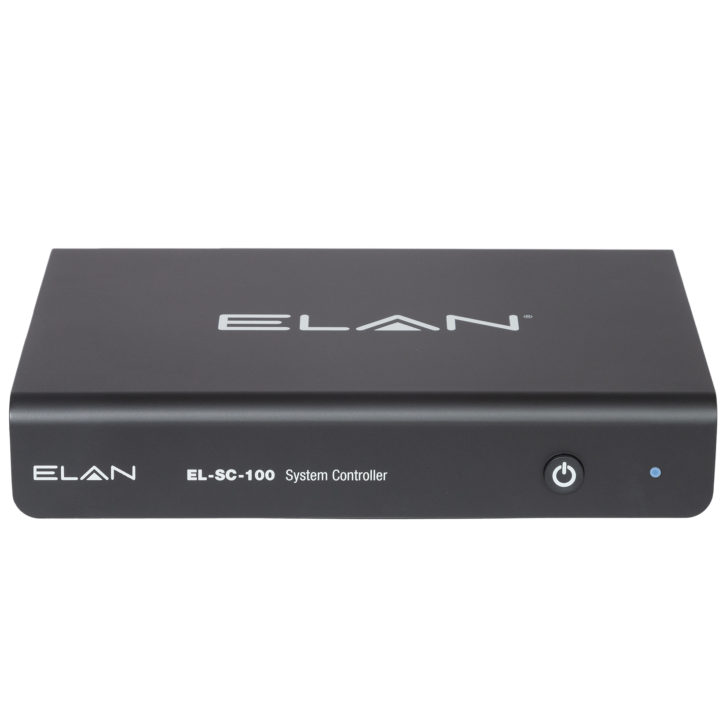 The Elan EL-SC-100 System Controller provides control for a wide range of AV and environmental control devices in a single, very compact form factor. Used with the HR10 remote and mobile app, the unit can operate door locks and even other hardware. The optional wiring cabinet mount (EL-SC-100-BKT) can fit the controller into a structured wiring cabinet for small to medium-sized media rooms and home theatre. It can also be used as an extender for larger systems primarily controlled by the gSC2 or gSC10. Based on the Quad-core 64-bit Cortex-A53 processor, the controller has RS-232, IR, Ethernet and USB ports.
The Elan EL-SC-100 System Controller provides control for a wide range of AV and environmental control devices in a single, very compact form factor. Used with the HR10 remote and mobile app, the unit can operate door locks and even other hardware. The optional wiring cabinet mount (EL-SC-100-BKT) can fit the controller into a structured wiring cabinet for small to medium-sized media rooms and home theatre. It can also be used as an extender for larger systems primarily controlled by the gSC2 or gSC10. Based on the Quad-core 64-bit Cortex-A53 processor, the controller has RS-232, IR, Ethernet and USB ports.
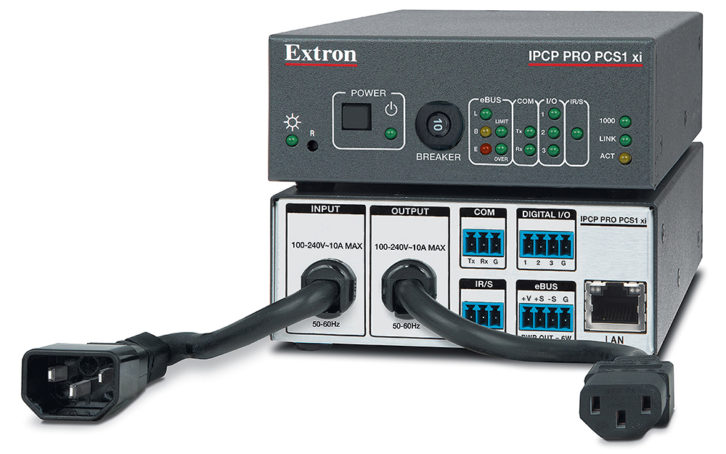 The Extron IPCP Pro PCS1 xi IP Link Pro Power and Device Control Processor carries 1 GB of RAM and 8 GB of Flash memory to support TouchLink Pro touch panels, eBUS devices, and network button panels. It also has intelligent current sensing with an alarm, and if the unit loses power, the memory remains intact. Control signals are sent through a bidirectional RS-232 port with software handshaking, one IR/serial port, three digital I/O ports, and an eBUS port. The Ethernet port supports 10/100/1000Base-T. The ports also have front panel LED activity indicators.
The Extron IPCP Pro PCS1 xi IP Link Pro Power and Device Control Processor carries 1 GB of RAM and 8 GB of Flash memory to support TouchLink Pro touch panels, eBUS devices, and network button panels. It also has intelligent current sensing with an alarm, and if the unit loses power, the memory remains intact. Control signals are sent through a bidirectional RS-232 port with software handshaking, one IR/serial port, three digital I/O ports, and an eBUS port. The Ethernet port supports 10/100/1000Base-T. The ports also have front panel LED activity indicators.
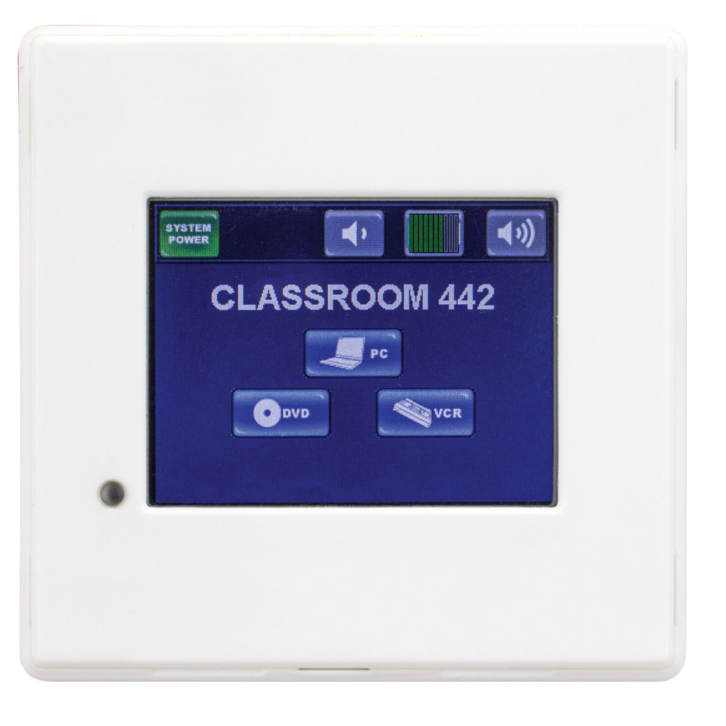 Mounted on a wall or on a desk, the FSR Flex-LT200 features a 3.5in. color touch control panel on which users can select and control various AV source devices, control volume, and operate shades, lights, and screens. The Flex-LT200 controls through IP, four serial ports, four IR ports, and four I/O ports. The built-in scheduler can shut the system off, power up at pre-set times, and alert tech support to make routine system and component checks. The Flex-Able configuration utility provides a simple drag-and-drop programming method to configure the system.
Mounted on a wall or on a desk, the FSR Flex-LT200 features a 3.5in. color touch control panel on which users can select and control various AV source devices, control volume, and operate shades, lights, and screens. The Flex-LT200 controls through IP, four serial ports, four IR ports, and four I/O ports. The built-in scheduler can shut the system off, power up at pre-set times, and alert tech support to make routine system and component checks. The Flex-Able configuration utility provides a simple drag-and-drop programming method to configure the system.
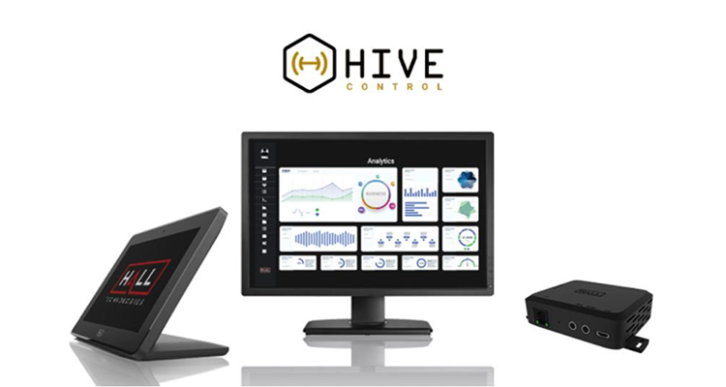 In January Hall Technologies HIVE Control was announced. It’s an AV system combining IoT, legacy control, and automation technology. HIVE Control is comprised of three key elements: HIVE Control, Touch, and Node. HIVE Cloud Control provides users with 24/7 control to configure, manage, and service multiple clients from anywhere in the world; this subscription-based asset management platform allows users to connect an unlimited number of rooms under one subscription for quick and easy integration and infinite scalability. HIVE Control uses a node-based architecture that does not require a centralized server or the purchase of gateway devices. Instead, the HIVE Touch and HIVE Node are designed to directly connect to all existing AV hardware, including legacy devices without the need for programming. The HIVE Touch is an all-in-one touch panel display engineered to control any ProAV hardware and automation devices in any room. HIVE Control is the first of many integrated products that will launch over the course of the year.
In January Hall Technologies HIVE Control was announced. It’s an AV system combining IoT, legacy control, and automation technology. HIVE Control is comprised of three key elements: HIVE Control, Touch, and Node. HIVE Cloud Control provides users with 24/7 control to configure, manage, and service multiple clients from anywhere in the world; this subscription-based asset management platform allows users to connect an unlimited number of rooms under one subscription for quick and easy integration and infinite scalability. HIVE Control uses a node-based architecture that does not require a centralized server or the purchase of gateway devices. Instead, the HIVE Touch and HIVE Node are designed to directly connect to all existing AV hardware, including legacy devices without the need for programming. The HIVE Touch is an all-in-one touch panel display engineered to control any ProAV hardware and automation devices in any room. HIVE Control is the first of many integrated products that will launch over the course of the year.
 High Resolution Systems has an incredibly versatile large-scale control solution in the HRS Enterprise Pro Rack, featuring up to 100 independent control systems, each with built-in browser configuration. All of this is configured through the HRS System Designer web app that can also be used for custom driver development. There are network interfaces for IR, RS-232 and contact closures as well as complex macros and system scheduling. The whole operation is powered by a 3.5 GHz Intel XEON and 32GB memory.
High Resolution Systems has an incredibly versatile large-scale control solution in the HRS Enterprise Pro Rack, featuring up to 100 independent control systems, each with built-in browser configuration. All of this is configured through the HRS System Designer web app that can also be used for custom driver development. There are network interfaces for IR, RS-232 and contact closures as well as complex macros and system scheduling. The whole operation is powered by a 3.5 GHz Intel XEON and 32GB memory.
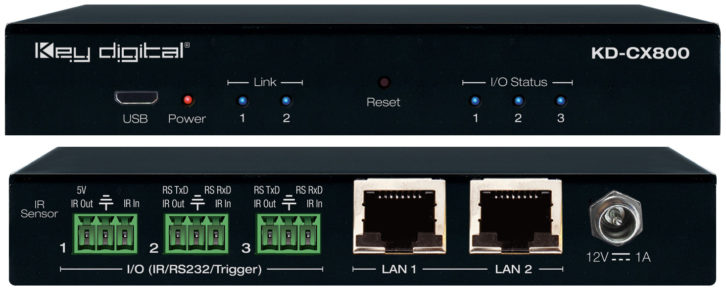 The Key Digital KD-CX800 control interface can be used in any of four modes. The first is as a control gateway for enterprise AV over an IP system. In the second mode, it is a Compass Control Master Controller. In mode three, it provides third-party control via KeyCode Open API, and in Mode 4, it functions as an IP control extension. Powered by a separate power supply or via PoE, the unit has a voltage sensing trigger, IP ports, serial ports, and twin LAN ports; the front panel features LED status indicators for the various ports.
The Key Digital KD-CX800 control interface can be used in any of four modes. The first is as a control gateway for enterprise AV over an IP system. In the second mode, it is a Compass Control Master Controller. In mode three, it provides third-party control via KeyCode Open API, and in Mode 4, it functions as an IP control extension. Powered by a separate power supply or via PoE, the unit has a voltage sensing trigger, IP ports, serial ports, and twin LAN ports; the front panel features LED status indicators for the various ports.
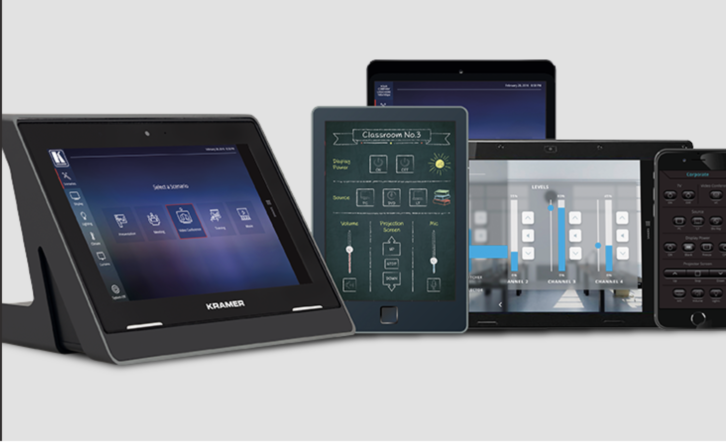 Kramer Control is a comprehensive cloud-based solution that continues to integrate with endpoint partners, most recently Allen & Heath. Kramer Control lets users navigate to any room in an organization and easily control AV systems, infrastructures, and devices, including Kramer wireless collaboration products, audio products and systems, thermostats, HVAC, lights, shades, alarms, security, video conferencing, and more. Based on a distributed architecture, it offers agility and scalability, catering to a single room or large global enterprise. The platform’s combination of software, hardware, and cloud is the result of years of research and development, an effort that received funding from the prestigious Israel-United States Binational Industrial Research and Development (BIRD) Foundation. The BIRD Foundation recognized the platform’s high level of innovation and contribution to the IoT field. The Kramer Control Platform is made up of three modules: Manager (for defining project content and scope), Builder (for drag-and-drop creation, editing and configuring of room control) and Analytics Dashboard (data and monitoring), with options for public, private, or hybrid cloud implementation. On site, Smart Units, powered by innovative software technology called a “Brain,” provide bi-directional control of any device, and the Manager, Builder, and Dashboard with universal I/O ports. The solution supports industry standards such as IR, serial RS-232, relays, and GPIO.
Kramer Control is a comprehensive cloud-based solution that continues to integrate with endpoint partners, most recently Allen & Heath. Kramer Control lets users navigate to any room in an organization and easily control AV systems, infrastructures, and devices, including Kramer wireless collaboration products, audio products and systems, thermostats, HVAC, lights, shades, alarms, security, video conferencing, and more. Based on a distributed architecture, it offers agility and scalability, catering to a single room or large global enterprise. The platform’s combination of software, hardware, and cloud is the result of years of research and development, an effort that received funding from the prestigious Israel-United States Binational Industrial Research and Development (BIRD) Foundation. The BIRD Foundation recognized the platform’s high level of innovation and contribution to the IoT field. The Kramer Control Platform is made up of three modules: Manager (for defining project content and scope), Builder (for drag-and-drop creation, editing and configuring of room control) and Analytics Dashboard (data and monitoring), with options for public, private, or hybrid cloud implementation. On site, Smart Units, powered by innovative software technology called a “Brain,” provide bi-directional control of any device, and the Manager, Builder, and Dashboard with universal I/O ports. The solution supports industry standards such as IR, serial RS-232, relays, and GPIO.
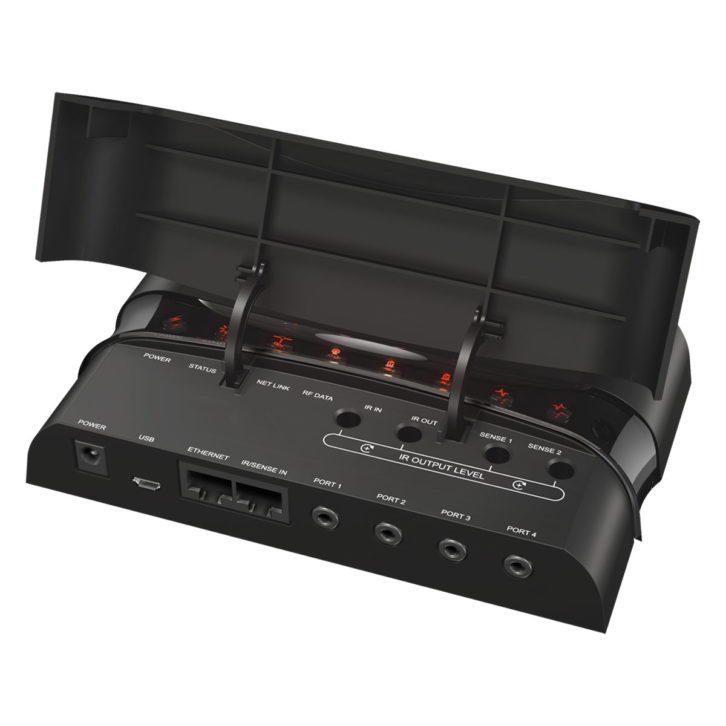 Home control and automation projects can use features of the PROControl ProLink.r Plus including its Ethernet port for programming. Responding via RF to either the Pro24.r or iPro.8 remotes using its integrated antenna, the ProLink.r Plus has two voltage sensing ports, four integrated IR routing ports, and unlimited storage for system commands and macros. There are four IR emitters included and the IR output strength is adjustable. It is compatible with the ProPanel App for iOS and programming can also be done through the USB port.
Home control and automation projects can use features of the PROControl ProLink.r Plus including its Ethernet port for programming. Responding via RF to either the Pro24.r or iPro.8 remotes using its integrated antenna, the ProLink.r Plus has two voltage sensing ports, four integrated IR routing ports, and unlimited storage for system commands and macros. There are four IR emitters included and the IR output strength is adjustable. It is compatible with the ProPanel App for iOS and programming can also be done through the USB port.
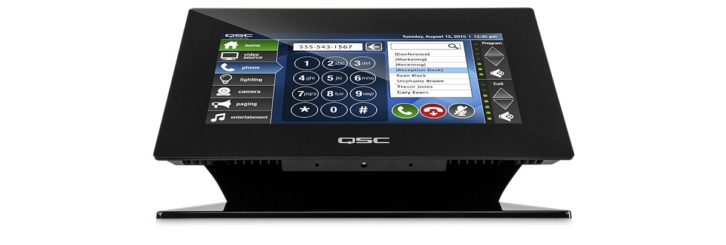 One of the most widely used software-based audio, video and control platforms is the QSC Q-SYS Ecosystem with its Intel processing foundation. Future-proofed through its usage of IT standard protocols, the system allows the integration of standard-based components from different third-party manufacturers as well as those made by QSC such as amplifiers and digital mixers. The platform is set up and configured through the Q-SYS Designer Software. Q-SYS Configurator allows configuration and Q-SYS design on web-enabled tablet devices. Q-SYS Reflect Enterprise Manager facilitates remote monitoring and management.
One of the most widely used software-based audio, video and control platforms is the QSC Q-SYS Ecosystem with its Intel processing foundation. Future-proofed through its usage of IT standard protocols, the system allows the integration of standard-based components from different third-party manufacturers as well as those made by QSC such as amplifiers and digital mixers. The platform is set up and configured through the Q-SYS Designer Software. Q-SYS Configurator allows configuration and Q-SYS design on web-enabled tablet devices. Q-SYS Reflect Enterprise Manager facilitates remote monitoring and management.
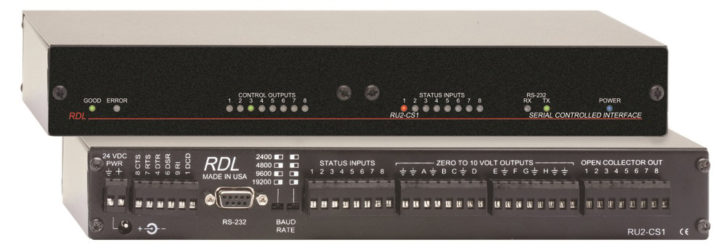 The Radio Design Labs (RDL) RU2-CS1 serial – controlled interface operates eight collector outputs and eight separate 0-10VDC outputs. This device can also respond to external switch or transistor closures with its eight status inputs. All outputs can be activated simultaneously or separately, and the ramp rate for each output can be preset. An initialization command sets all parameters to known values at the beginning of the user program and front panel LEDs show any active outputs, active status inputs, transmit and receive data, errors, and power.
The Radio Design Labs (RDL) RU2-CS1 serial – controlled interface operates eight collector outputs and eight separate 0-10VDC outputs. This device can also respond to external switch or transistor closures with its eight status inputs. All outputs can be activated simultaneously or separately, and the ramp rate for each output can be preset. An initialization command sets all parameters to known values at the beginning of the user program and front panel LEDs show any active outputs, active status inputs, transmit and receive data, errors, and power.
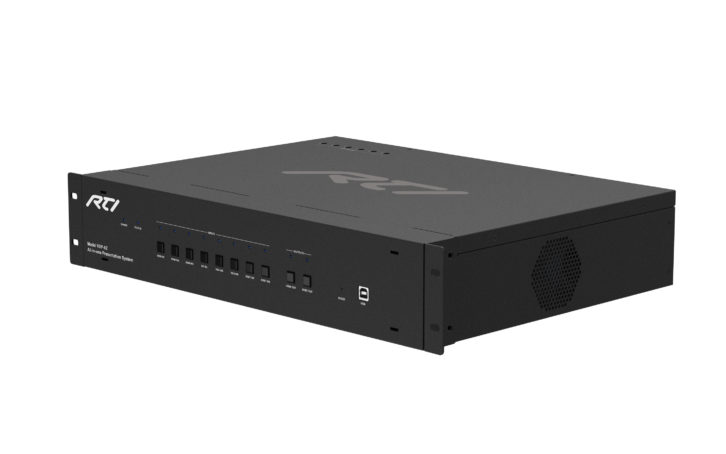 RTI puts control processing and presentation switching into the same device with the RTI VXP-82. Occupying two rack spaces, the unit allows control from RTI control panels, touch pads, remote controls, and mobile apps. The 8×2 switcher handles signals from a wide range of AV sources and sends them out via HDMI and HDBaseT. Features include KVM control over USB, a builtin 4K video scaler, and an audio mixer that can mix de-embedded audio of HDMI and HDBaseT outputs. The unit can be controlled on the front panel, the integral processor, and Web UI.
RTI puts control processing and presentation switching into the same device with the RTI VXP-82. Occupying two rack spaces, the unit allows control from RTI control panels, touch pads, remote controls, and mobile apps. The 8×2 switcher handles signals from a wide range of AV sources and sends them out via HDMI and HDBaseT. Features include KVM control over USB, a builtin 4K video scaler, and an audio mixer that can mix de-embedded audio of HDMI and HDBaseT outputs. The unit can be controlled on the front panel, the integral processor, and Web UI.
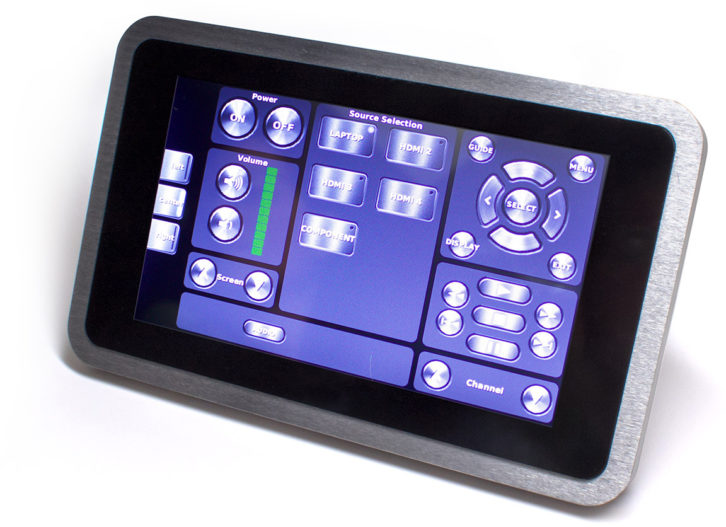 The SP Controls SP-TP7 uses a high luminosity capacitive color display to allow simple presentation system setup and control and it can be used to quickly upgrade systems currently using PixiePro control units. The touch panel can be wall, rack, table top, or lectern mounted and it can use SP Controls’ extensive driver library to match control to device. Through the SP Controls SmartView Web software there is remote access, management, and control of AV assets in multiple rooms and buildings on the network.
The SP Controls SP-TP7 uses a high luminosity capacitive color display to allow simple presentation system setup and control and it can be used to quickly upgrade systems currently using PixiePro control units. The touch panel can be wall, rack, table top, or lectern mounted and it can use SP Controls’ extensive driver library to match control to device. Through the SP Controls SmartView Web software there is remote access, management, and control of AV assets in multiple rooms and buildings on the network.
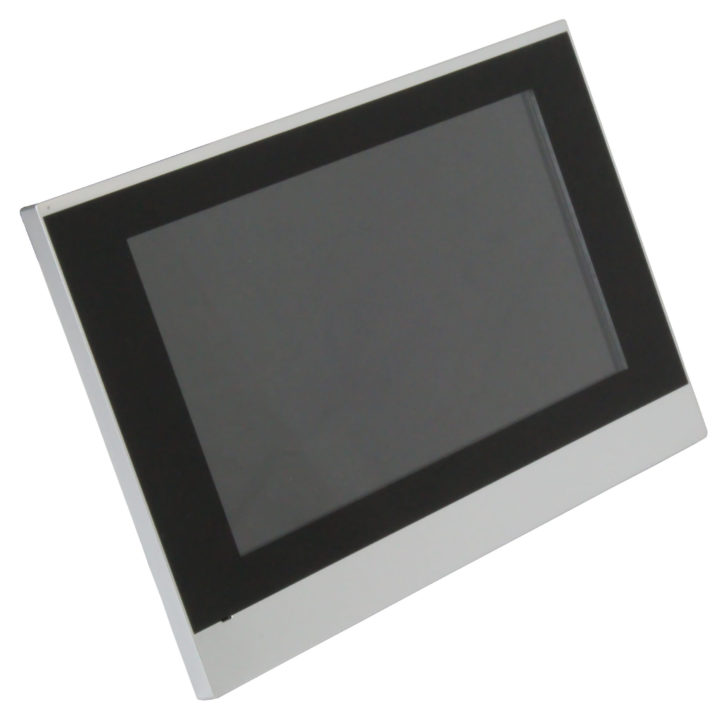 Another versatile touch screen control solution is the Tekvox TXC7 with its 7in. capacitive display and 1024×600 resolution. For easy installation it is powered on PoE and includes a second, non-PoE Ethernet port for control of additional devices. The TXC7 can also import AMX and Crestron control layouts into its 1GB RAM with 4GB flash memory and the user interface can be customized to perfectly suit the specific facility and users. It is light (.8 lbs) and small enough to mount on a table or wall and the mounting hardware is included. The all-metal construction assures long-time durability.
Another versatile touch screen control solution is the Tekvox TXC7 with its 7in. capacitive display and 1024×600 resolution. For easy installation it is powered on PoE and includes a second, non-PoE Ethernet port for control of additional devices. The TXC7 can also import AMX and Crestron control layouts into its 1GB RAM with 4GB flash memory and the user interface can be customized to perfectly suit the specific facility and users. It is light (.8 lbs) and small enough to mount on a table or wall and the mounting hardware is included. The all-metal construction assures long-time durability.
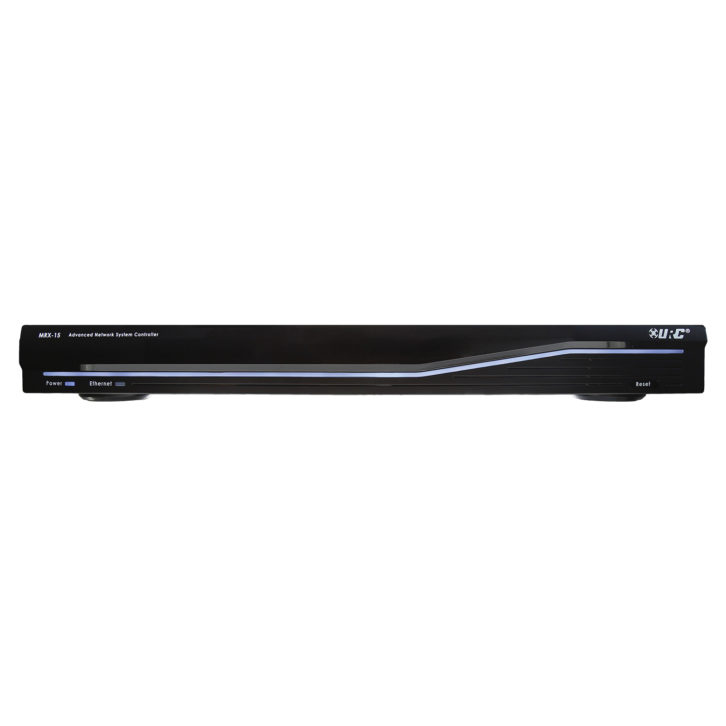 The single RU Universal Remote Control MRX-15 Total Control smart automation and control system communicates with both URC products and compatible third-party devices. It uses IP, IR, RS-232, sensors, relays, and 12-volt control to connect and it can store and run complex control/automation commands. This model also integrates with Amazon Alexa and Google Assistant for voice control. The front panel features power and Ethernet LEDs. Included are 8 IR emitters, an adjustment tool, rack mount ears, power cord, and Ethernet cable.
The single RU Universal Remote Control MRX-15 Total Control smart automation and control system communicates with both URC products and compatible third-party devices. It uses IP, IR, RS-232, sensors, relays, and 12-volt control to connect and it can store and run complex control/automation commands. This model also integrates with Amazon Alexa and Google Assistant for voice control. The front panel features power and Ethernet LEDs. Included are 8 IR emitters, an adjustment tool, rack mount ears, power cord, and Ethernet cable.
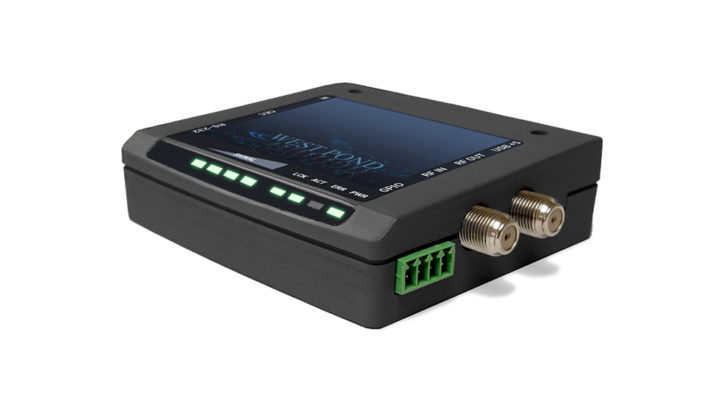 Among the smart headend hardware provided by West Pond Enterprises is the RX-50 Managed Display Controller for managing TVs with integrated tuners. Typically used in the display systems of hospitals, hotels, corporate offices and stadiums on coax or an IPTV network, the RX-50 works in conjunction with MX-400 smart headends and other equipment. This device uses the existing coax to carry its control commands. The display state can be set using CEC on the TV’s HDMI port, RS-232, IR, or via a power relay using the internal GPIO controls. After initial connection of its USB port to existing headend gear, the RX-50 automatically registers with the WPE MX product and performs auto-discovery of the appropriate control channel.
Among the smart headend hardware provided by West Pond Enterprises is the RX-50 Managed Display Controller for managing TVs with integrated tuners. Typically used in the display systems of hospitals, hotels, corporate offices and stadiums on coax or an IPTV network, the RX-50 works in conjunction with MX-400 smart headends and other equipment. This device uses the existing coax to carry its control commands. The display state can be set using CEC on the TV’s HDMI port, RS-232, IR, or via a power relay using the internal GPIO controls. After initial connection of its USB port to existing headend gear, the RX-50 automatically registers with the WPE MX product and performs auto-discovery of the appropriate control channel.


